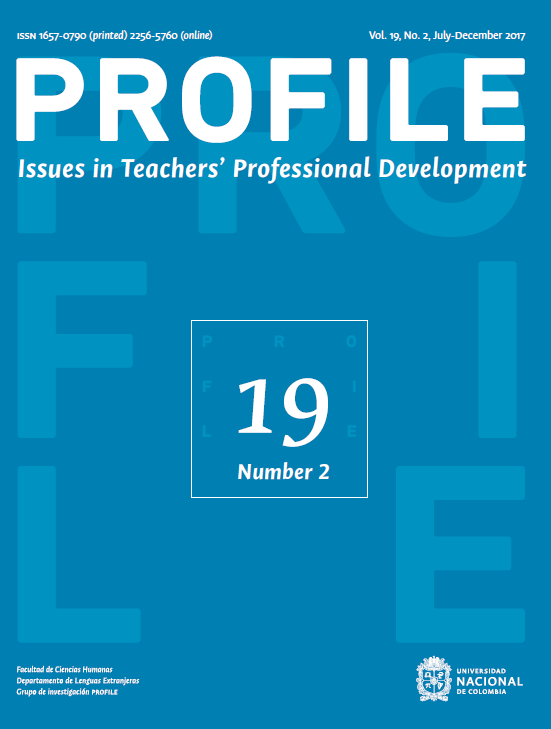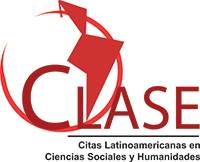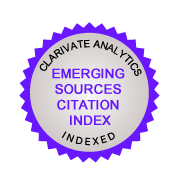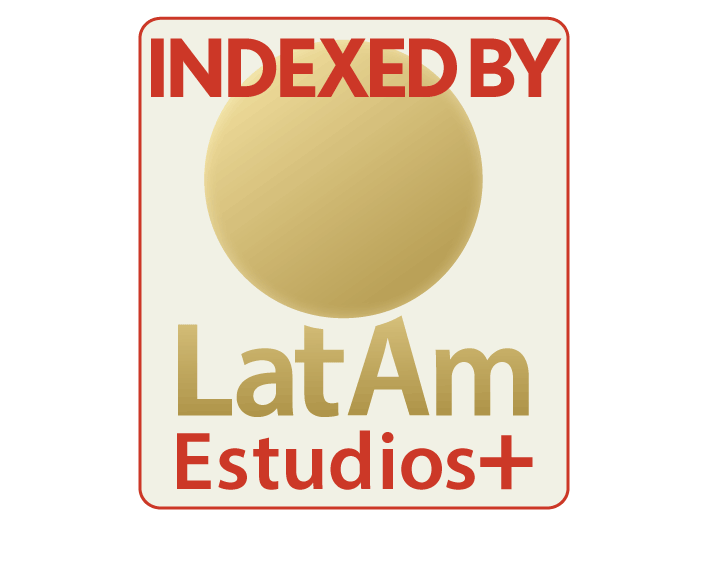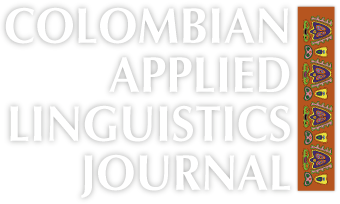Formulaic Language and EFL Requests: Sensitive Wording at the Right Time
Lenguaje formulaico y peticiones en inglés: formulación apropiada en el momento oportuno
DOI:
https://doi.org/10.15446/profile.v19n2.57428Keywords:
English as a foreign language, formulaic language, pragmatics, requests (en)Inglés como lengua extranjera, lenguaje formulaico, peticiones, pragmática (es)
I examine whether teaching formulaic language raises English as a foreign language learners’ awareness of pragmatic resources when expressing requests. To carry out this research I adopt a qualitative self-reflective approach which encourages students to use formulaic language when making requests. By responding to discourse completion tasks, learners were given the opportunity to reflect on whether the use of formulaic language enhances their ability to come across in acceptable and appropriate ways. Results indicate that by developing learners’ knowledge and via the use of pragmalinguistic and sociopragmatic resources, students at all levels have a much greater chance of achieving their communicative objectives and of becoming more pragmatically competent in the target language when making requests.
https://doi.org/10.15446/profile.v19n2.57428
Formulaic Language and EFL Requests: Sensitive Wording at the Right Time
Lenguaje formulaico y peticiones en inglés: formulación apropiada en el momento oportuno
Gerrard Mugford*
Universidad de Guadalajara, Guadalajara, Mexico
This article was received on May 14, 2016, and accepted on December 3, 2016.
How to cite this article (APA, 6th ed.): Mugford, G. (2017). Formulaic language and EFL requests: Sensitive wording at the right time. PROFILE Issues in Teachers’ Professional Development, 19(2), 29-39. https://doi.org/10.15446/profile.v19n2.57428.
This is an Open Access article distributed under the terms of the Creative Commons license Attribution-NonCommercial-NoDerivatives 4.0 International License. Consultation is possible at http://creativecommons.org/licenses/by-nc-nd/4.0/.
I examine whether teaching formulaic language raises English as a foreign language learners’ awareness of pragmatic resources when expressing requests. To carry out this research I adopt a qualitative self-reflective approach which encourages students to use formulaic language when making requests. By responding to discourse completion tasks, learners were given the opportunity to reflect on whether the use of formulaic language enhances their ability to come across in acceptable and appropriate ways. Results indicate that by developing learners’ knowledge and via the use of pragmalinguistic and sociopragmatic resources, students at all levels have a much greater chance of achieving their communicative objectives and of becoming more pragmatically competent in the target language when making requests.
Key words: English as a foreign language, formulaic language, pragmatics, requests.
Examino la enseñanza de lenguaje formulaico para expresar peticiones con el objetivo de aumentar los recursos pragmáticos de los alumnos de inglés como lengua extranjera. Para llevar a cabo esta investigación adopto un enfoque cualitativo y auto-reflexivo que alienta a los estudiantes a utilizar el lenguaje formulaico para expresar peticiones. Al responder a textos con situaciones discursivas, los estudiantes tuvieron la oportunidad de examinar si el uso de lenguaje formulaico mejora su habilidad para interactuar en formas aceptables y apropiadas. Los resultados indican que al desarrollar sus conocimientos y el uso de recursos pragmalingüísticos y sociopragmáticos, los estudiantes en todos los niveles tienen una mayor probabilidad de alcanzar sus objetivos comunicativos y de ser pragmáticamente más competentes cuando expresan peticiones en la lengua meta.
Palabras clave: inglés como lengua extranjera, lenguaje formulaico, peticiones, pragmática.
Introduction
This paper was motivated by the observation that my English as a foreign language (EFL) students’ use of the target language inside and outside the classroom in Mexico reflects, by and large, grammatical accuracy in making requests, but lacks contextual sensitivity. For instance, when wanting to talk to a teacher, students often start the conversation in the following way:
- “I have a question...”
- “I want to ask you something...”
- “I need to talk to you...”
- “I have a problem...”
Without determining whether the addressee is available or willing to comply, students run the risk of being seen as imposing before they have even had a chance to formulate the request itself.
In order to raise my students’ awareness of the potential problem when formulating requests and exploring possible options, I presented a class of 26 advanced language students with eight situations where they were asked to frame a request. They were not given any previous instruction on making requests and were free to answer in any way they wanted. The answers revealed that the students often failed to convey appropriate levels of consideration, indirectness, and politeness. Consequently, through classroom instruction, I presented learners with pragmatic resources for conveying requests. In a follow-up class, learners were asked to respond to the same situations with the aim of ascertaining whether they now came across in politer ways. However, rather than correcting the learners’ work, I asked them to compare their own answers before and after instruction and reflect on which answers conveyed greater sensitivity and appropriateness. I argue that this is a more effective way of raising students’ awareness than the teacher providing feedback on the correctness of learners’ answers.
Literature Review
In this section I define and discuss the concept of formulaic language in terms of conversational routines and I outline the importance of formulaic language in developing fluency in the target language.
Formulaic Language
The use of formulaic sequences are widespread in language use and covers a wide range which, following Carter (1998) and Wray (2008), includes idioms, collocations, proverbs, catchphrases, quotations, idiomatic similes, and discoursal expressions such as social formulae (e.g., How’s it going?) and structuring devices (e.g., Let’s get started!). Formulaic language is, therefore, an umbrella term that refers “to the larger units of processing—that is, lexical units that are more than one word long” (Wray, 2008, p. 3). However, such a definition reveals little about the pragmatic dimension of formulaic expressions as language users construct and convey communicative meaning.
To embrace the pragmatic dimension in “fixed and semi-fixed multi-word phrases (or lexical chunks),” Thornbury and Slade (2006) differentiate between lexical phrases and conversational routines. They contrast lexical phrases, which are “multi-word items that constitute a single grammatical unit (such as a verb, noun, or adjective) but have no specific pragmatic function,” (pp. 62-63) with conversational routines which convey pragmatic information contained in “fillers, discourse markers, utterance launchers, tags, expletives etc.” (p. 63).
Conversational routines reflect a socio-interactional function (Thornbury & Slade, 2006) which can be key to successfully making requests. As argued by Aijmer (1996), requests can be conveyed through a range of strategies including ability (e.g., could you...), willingness (e.g., will you...), and want (e.g., I want you...). However, request strategies cannot solely rely on grammatical functions. They also need to be tempered by politeness strategies depending on the addressee and the context. Politeness may adopt one of the following strategies:
- The use of a question instead of a declarative sentence.
- The choice of a suggestion rather than a request.
- The choice of modal auxiliary.
- The choice of subject.
- Giving reasons for doing something rather than stating one’s wishes abruptly.
- Softening the force of an impassive speech act. (Aijmer, 1996, p. 138)
Formulaic language can provide foreign-language users with ready-made pre-fabricated expressions (Nattinger & DeCarrico, 1992) so that they can fluently negotiate such face-threatening acts (Brown & Levinson, 1987) as making a request since this may threaten the face (Goffman, 1967) of the addressee.
Formulaic Language, Pragmatics, and EFL
An essential aspect to achieving communicative competence (Bachman, 1990; Canale, 1983) in the target language is the development of pragmatic competence. LoCastro (2012) defines pragmatic competence as “the knowledge that influences and constrains speakers’ choices regarding use of language in socially appropriate ways” (p. 307). Pragmatic competence is key to formulating appropriate requests in the target language because interactants need to know what acceptable and permissible choices are in a given context.
Giving learners formulaic expressions helps them to develop appropriate request strategies and saves them time in having to construct a request strategy every time they wish to make a request. Furthermore, Widdowson (1990) argues that formulaic expressions “figure so prominently in competence, it does not seem reasonable just to disregard their existence and leave their learning to chance” (pp. 95-96). Nattinger and DeCarrico (as cited in Widdowson, 1989) argue that
communicative competence is not so much a matter of knowing rules for the composition of sentences and being able to appropriately employ such rules as it is “knowing a stock of partially preassembled patterns, formulaic frameworks, and a kit of rules, so to speak, and being able to apply the rules to make whatever adjustments are necessary according to contextual demands”. (p. 135)
This argument places formulaic expressions in a strong position for helping to develop communicative competence in the target language. Carter and McCarthy (1997) argue that “fixed expressions play an important part in spoken language in particular in maintaining and establishing relationships and in reinforcing shared knowledge and social conventions, and referring to common cultural understandings” (p. 15). Furthermore, Thornbury and Slade (2006) argue that knowledge of formulaic expressions helps EFL users to save time when communicating or even to gain time when formulating their utterances.
Developing Pragmatic Resources
Making a request potentially threatens the face of the respondent (Brown & Levinson, 1987) as it intrudes on the addressee by potentially limiting his/her freedom of action (Cohen & Ishihara, 2010; Márquez Reiter, 1997) and exposes the requester to possible rejection. In order to maximise the possibilities of success, the requester needs to show thoughtfulness, justification for making the request, and a willingness to compensate the respondent on an appropriate occasion in the future. This can be achieved by minimising the level of intrusion by employing mitigation, avoiding imposition through the use of indirectness (Leech, 2014), and boosting the face of the respondent through rapport enhancement (Spencer-Oatey, 2008).
Whilst the teaching of requests has largely concentrated on practising correct structures (e.g., the use of the modals can and could), EFL teachers often fail to alert learners to the basic motivations behind request strategies which stem from “neg-politeness” whose “function is mitigation, to reduce or lessen possible cause of offense” (Leech, 2014, p.11). Therefore, when formulating requests, EFL learners should be made aware of how to express consideration, give a justification, enhance the face of the respondent, and convey gratitude. This can be done in the following ways:
- Demonstrating consideration. This may be direct or indirect and involves recognising that the requester is taking up the addressee’s time, asking whether he/she is available and presupposing his/her willingness to comply. Consideration can be expressed checking on availability: Can you give me a second? (direct) and Are you busy at the moment? (indirect);preparators: I need you to do me a favour (direct) and I would really like to ask you something (indirect);getting a pre-commitment: Please don’t say no (direct) and Is there any chance of you doing me a favour? (indirect); and minimising the imposition: This will only take a minute of your time (direct) and I know you are a really busy person (indirect)(Ishihara, 2010; Spencer-Oatey, 2008).
- Focusing on the reason behind the request as the speaker aims to achieve compliance through the use of grounders: I came away from home without my wallet; downgrading the imposition: I see you are not using your calculator at the moment. Any chance of using it? (Spencer-Oatey, 2008).
- Boosting the face of the respondent through rapport enhancement by making the addressee feel good (Lakoff, 1973). This can be done through sweeteners: if there is someone I can always count on for help; and everyone says you’re the right person to ask.
- Showing willingness to compensate by promising to pay the respondent back: Just ask me any time, and I’ll help you with anything you need; by displaying indefinite gratitude: I will be eternally grateful; by offering actual payment: I’ll pay you for your time (Ishihara, 2010; Spencer-Oatey, 2008).
The use of these pragmatic devices allows target-language users to minimise potential offence when conveying requests and this may need to be explained to EFL learners.
Research Framework
To understand how formulaic expressions can help EFL users construct appropriate requests, I adopt a qualitative research approach that aims to build on the pragmalinguistic resources (Leech, 1983; Thomas, 1983) that the learners already employ to convey requests. I try to raise their awareness of whether they were employing pragmalinguistic resources appropriately or not. Furthermore, Thornbury and Slade (2006) argue that an underuse of formulaic language leaves EFL users “relying on their grammatical knowledge to generate well-formed but essentially unidiomatic language” (p. 219). Therefore, my underlying research question is: Can EFL users be encouraged to use formulaic expressions to develop and reinforce the appropriate use of request strategies?
Language of Description
In order to construct a language of description to evaluate whether students improved their performance in making requests, I adopt Leech’s (1983) and Thomas’s (1983) use of pragmalinguistic and sociopragmatic resources. Pragmalinguistic resources reflect the different ways of carrying out a speech act. This may range from using direct or indirect language to using softeners and intensifiers (Kasper & Rose, 2001). Meanwhile, sociopragmatic resources are used to implement the appropriate use of pragmalinguistic resources in a given context, taking into consideration, for example, the interpersonal relationship, the level of closeness/distance, and degree of power (Kasper & Rose, 2001).
The use of formulaic expressions provides pragmalinguistic resources for making requests. However, these need to be used in ways that are appropriate, sensitive to the addressee, and applicable to the context.
Method
To raise EFL users’ awareness of their use of request strategies, I adopt a reflective experiential research approach which encourages students to notice and develop a self-awareness of their own language use. This is especially challenging “since pragmatic language use is a very complex phenomenon with a lot of contextual factors influencing its actual performance [therefore,] it is of paramount importance to carefully design the methods that elicit learners’ production or comprehension/awareness of a particular pragmatic feature” (Martínez-Flor & Usó-Juan, 2011, p. 49). In order to collect learner response data, I used “production questionnaires” or discourse completion tasks (DCTs) “which require the informant to produce some sort of authentic language data as a response to situational prompts” (Dörnyei, 2007, p. 103). Therefore, I asked students to review their own use of requests and after instructional intervention, to reflect on any perceivable changes they could identify in their own work. I carried this out using pre-teaching, teaching, and post-teaching phases.
In the pre-teaching phase, students were asked to respond to eight DCTs. In a follow-up activity, two weeks later, students were asked to reflect on their answers and take into account sociopragmatic aspects such as closeness/distance and level of imposition placed on the respondent.
In the teaching phase, students were given a range of formulaic expressions that focused on the addressee’s availability (e.g., Are you busy?), softening the reasons behind the request (e.g., I know you don’t like to lend...) and cross-cultural differences (e.g., level of directness). With these expressions, students were in a position to increase their range of pragmalinguistic and sociopragmatic resources.
In the post-treatment stage, students revisited the DCTs and wrote and developed new responses. In a follow-up stage, they compared the results from their first attempt with those of their second attempt and evaluated by themselves whether they considered that there had been an improvement in their strategies.
This reflective approach aimed to make students themselves aware of their own progress rather than putting the teacher in the evaluative role.
Participants
The participants in the study comprised 26 advanced-level Mexican students, studying at a public university in Guadalajara, Mexico. They were between 20 and 24 years old, and there were 17 women and 9 men. They had had very little contact with native speakers so that they had had extremely limited exposure to “authentic L2 output” (Thornbury & Slade, 2006, p. 219). This means that they very often relied on grammatical forms and knowledge to formulate requests rather being able to reflect and reproduce actual target-language usage.
Instrument
DCTs or “production questionnaires” (Dörnyei, 2007, p. 103) were used because they offered students an opportunity to reflect on their response and examine different ways of requesting. However, DCTs suffer from the drawback that they lack spontaneity and project what participants might say rather than what they would actually say. However, I am trying to identify the resources that the participants want to employ and the two sets of answers give students one way to evaluate their progress.
Initial Class: Making Requests
Without any previous pedagogical intervention, I asked learners to respond to the eight situations. The situations invited students to request help from teachers, peers, and work colleagues and focused on borrowing computers, seeking help studying, finding places on campus, and so on (see DCTs in the Appendix). For reasons of space I will only provide six responses. They are:
Handing in work late:
Excuse me, Mr. Klemz I couldn’t finish my homework because it seems difficult for me, is there a problem if I give it to you later?
Morning teacher, I couldn’t hand my homework on time because I couldn’t print it correctly, could you give me an extension?
When requesting to hand in work late, the requesters used alerters (Spencer-Oatey, 2008) such as “Excuse me, Mr Klenz”,and “Morning teacher” but used little mitigation which may have been expected in a student-teacher relationship. However, there was indirectness e.g., “Is there a problem if I give it to you later?” and “Could you give me an extension?”
Seeking help from another student:
Hey, I really try but I haven’t understood anything these two weeks, can you help me to catch up?
Hello, can you help me out with the class please?
When seeking help from another student, there was minimum greeting and no checking as to the respondent’s availability or a willingness to help. Instead, there was the direct “Can you help me to catch up?” and “Can you help me out . . . ?” The respondents were not given the option of refusing.
Borrowing a computer:
Excuse me. I’m having problems with my laptop and I need to present. May I borrow yours, please?
Hi, I got a serious problem here. I’m supposed to give a presentation but my laptop is totally dead. Would you be so kind to lend me use yours for the next hour?
When wanting to borrow a computer, there was a minimum of greeting but some use of grounders e.g., “I’m having problems with my laptop” and “I got a serious problem here. I’m supposed to give a presentation but my laptop is totally dead.” However, there was no attempt to achieve a pre-commitment or offer a preparator. Rather, there was the direct request to borrow the computer.
In all these six answers there was no attempt at enhancing the respondent’s face or expressing gratitude. The answers indicated that the participants had some problems regarding the use of grammatical structures and vocabulary but these did not seriously diminish communication. Whilst employing modal verbs such as can, could, may, and would, students used a limited range of pragmatic sources and they were not sensitive to showing consideration, employing mitigation, and avoiding imposition.
I did not grade the work or comment on the appropriateness of the answers with the students.
Second Class: Reflecting on Requests
Two weeks later, and in order to sensitise the learners on how to make requests, I asked them to reread the DCTs individually and reflect on the contexts in terms of relationships (e.g., student-student and student-teacher), level of imposition placed on the respondent (e.g., borrowing a laptop and asking to hand in work late). I then asked the learners to look over their answers and to consider the appropriateness and acceptability of the answers. Consequently, the learners asked how their answers could sound more polite, less imposing, and more grateful.
Third Class “Teaching” Requests
In the following week, in a third class, the students were presented with the pragmalinguistic “structure” of making a request. Students were shown how to express consideration, mitigate the request, make the respondent feel “good”, offer repayment in the future and convey gratitude. Teacher instruction aimed to help learners to realise that the use of formulaic language can aid them in appropriately formulating requests.
Consideration can be expressed by asking whether the addressee is available, giving him/her freedom of action to comply and acknowledging the possible inconvenience of the request. Availability can be expressed with Are you free? and Do you have a minute? Freedom of action options include I wonder if you could help me... and Can I ask you something? Acknowledging the inconvenience of the request can be formulated with I don’t want to bother you but... and I know you’re a really busy person... At the same time, and as previously mentioned, consideration can be expressed indirectly to show even more thoughtfulness towards the respondent.
By explaining the reasons behind the request, the requester can reduce possible “burden” and “irritation” factors. Weighty requests that demand significant time and attention can be justified with expressions such as I know this is a lot to ask... and I would not normally ask you this... Requests that ask the respondent to do something that he/she is not normally prepared to do can be prefaced with I know you don’t like to lend your things... and I know you are really careful with... In doing so, the requester may try to highlight uniqueness and the fact that he/she would not in normal circumstances make this request.
In expressing gratitude, offering repayment, and making the respondent feel good, the requester needs to consider levels of effort and inconvenience required to carry out the request. Minor requests may need to be accompanied by only a cursory display of gratitude. However, serious requests may be accompanied by more heartfelt expressions. Gratitude may be immediate, future, or indeterminate: I really appreciate your doing this for me and I am so grateful (immediate); I will show my thanks by... and I will take you out next week (oriented towards the future); and I will be ever so grateful and I will be eternally grateful (indeterminate). Repayment can also be immediate (e.g., I will obviously pay you for your trouble) focused on the future (e.g., I can pay you back next week) and be indeterminate (e.g., I will do the same for you one day). Meanwhile, making the respondent feel good can be achieved by recognising his/her knowledge, skills, and disposition: You know all about this and You have studied this (knowledge), You’re really good at this and You have a knack/flair for... (skills) and You are a person who always... and If there is someone I can rely on... (disposition).
When making a request, the EFL user also needs to take into account possible pragmalinguistic and sociopragmatic cross-cultural differences. For instance, English tends to rely heavily on indirectness and distancing with, for example, the semi-formulaic Would you mind... and I wonder, would you be willing to...? (Leech, 2014, p. 143). By comparison, Mexican Spanish—the first language of these students—often employs imperatives to convey requests. For instance, there is a notable contrast between Would you mind lending me a pen in English and Préstame una pluma (Lend me a pen) in Spanish. EFL learners need to understand that there may be considerable differences in request strategies between their first language and the target language and teachers can play a key role in alerting students to such differences.
Fourth Class: Re-Making Requests
Three weeks later, the learners were again asked to respond to the eight situations. They were not given any additional instructions regarding how to respond to the DCTs. However, the underlying hope and expectation was for students to employ pragmatic strategies that had been presented and discussed in the previous class, that is, how to express consideration, to mitigate the request, to make the respondent feel “good”, to offer repayment in the future, and to convey gratitude as part of the “structure” of making a request.
Fifth Class: Follow up Results
In the final class the following week, students were presented with the two sets of responses that they had given to the eight situations: the pre-instruction and the post-instruction responses. The students were asked to evaluate whether they thought that there had been an improvement or a more extensive use of formulaic expressions in their post-instruction answers. For reasons of space, only a limited number of examples with much edited comments from the students can be offered.
In the following example, the learner argued that the post-instruction request to hand in work late was an improvement:
Pre: Excuse me, Mr. Klemz I couldn’t finish my homework because it seems difficult to me, is there a problem if I give it to you later?
Post: I know you don’t like to receive homework after the date you specified. Could you give me the opportunity to give you the homework later?
The student argued that the post-instruction response reduces possible annoyance factors behind the request with “I know you don’t like to receive” and through the use of the modal could.
In the following example, also asking to hand in work late, the post-instruction response shows more consideration and indirectness:
Pre: Morning teacher, I couldn’t hand my homework on time because I couldn’t print it correctly, could you give me an extension?
Post: I know that you don’t like to receive homework late but I would like to ask you for an extension because I had some issues and I couldn’t deliver it.
The post-instruction response is less imposing on the teacher with “I know that you don’t like...” and the use of the modality “I would like...” By comparison, the pre-instruction response fails to demonstrate sufficient consideration or the option to refuse.
In both cases, the post-instruction responses appear to recognise the status of the teacher and give him/her due recognition through the use of formulaic expressions that demonstrate indirectness and tentativeness.
When asking for help from another student, the students showed more consideration in the post-instruction responses and gave the respondents more options to comply as can be seen in the following example:
Pre: Hey, I really try but I haven’t understood anything these two weeks, can you help me to catch up?
Post: Excuse me, it is really difficult for me to understand the teacher, and I see that you are really good at it. Could you help me and explain me the most important topics so far?
The post-instruction response begins with the alerter (“Excuse me”), an explanation (“It is really difficult for me...”) and an attempt to make the hearer feel good (“I see that you are really good at it”). This signals an improvement over the pre-instruction response which is more imposing, direct, and offers few options to refuse.
The progress of some learners was more noticeable than others. I was less interested in seeing learners achieve target-language accuracy and more in expecting an improvement in their own terms. For instance, in the following example there was an overall improvement since the request showed more optionality even if the basic request stayed the same:
Pre: Hello, can you help me out with the class please?
Post: Hey, Ismael, can you help me out with the class? Whenever you have free time, I’d appreciate it.
In this example, the learner did not change his request for help which may still be seen as demanding, but at least there was an attempt at consideration with “Whenever you have free time” and a display of gratitude with “I’d appreciate it”.
Whilst the post-instruction responses may not reflect target-language requests, they do reflect an improvement over the initial attempts and, more importantly, communicatively offer more chances of success.
Conclusion
The learners were given the opportunity to critically examine their own answers and reach their own conclusions regarding pragmalinguistic and sociopragmatic appropriateness and acceptability. Whilst the post-instruction responses can still be improved on grammatically and pragmatically, they reflect the first step in raising EFL learners’ awareness regarding their use of the target language. As a teaching mode, it promotes and encourages learner-centred understanding and development of language use and could be applied to other speech acts, for instance, complaining, disagreeing, and making excuses where it is important to come across in appropriate and acceptable ways.
I have answered my research question in that the teaching and learning of formulaic expressions can help EFL users come across in more appropriate and acceptable ways when making requests. This can be achieved by developing the learners’ knowledge and use of pragmalinguistic and sociopragmatic resources. Furthermore, formulaic language provides foreign-language users with ready-made pre-fabricated expressions (Nattinger & DeCarrico, 1992) so that they have a much greater chance of achieving their communicative objectives.
References
Aijmer, K. (1996). Conversational routines in English: Convention and creativity. London, UK: Longman.
Bachman, L. F. (1990). Fundamental considerations in language testing. Oxford, UK: Oxford University Press.
Brown, P., & Levinson, S. (1987). Politeness: Some universals in language usage. Cambridge, UK: Cambridge University Press.
Canale, M. (1983). From communicative competence to communicative language pedagogy. In J. C. Richards & R. W. Schmidt (Eds.), Language and communication (pp. 2-27). London, UK: Longman.
Carter, R. (1998). Vocabulary. London, UK: Routledge.
Carter, R., & McCarthy, M. (1997). Exploring spoken English. Cambridge, UK: Cambridge University Press.
Cohen, A. D., & Ishihara, N. (2010). Describing speech acts: Linking research and pedagogy. In N. Ishihara & A. D. Cohen (Eds.), Teaching and learning pragmatics (pp. 56-74). Harlow, UK: Longman.
Dörnyei, Z. (2007). Research methods in applied linguistics. Oxford, UK: Oxford University Press.
Goffman, E. (1967). Interaction ritual: Essays on face-to-face behaviour. Garden City, US: Anchor / Doubleday.
Ishihara, N. (2010). Class observation and teaching demonstrations. In N. Ishihara & A. D. Cohen (Eds.), Teaching and learning pragmatics (pp. 123-144). Harlow, UK: Longman.
Kasper, G., & Rose, K. R. (2001). Pragmatics in language teaching. In K. R. Rose & G. Kasper (Eds.), Pragmatics in language teaching (pp. 1-10). Cambridge, UK: Cambridge University Press. http://doi.org/10.1017/CBO9781139524797.003.
Lakoff, R. (1973). The logic of politeness: Or minding your p’s and q’s. In C. Corum, T. C. Smith-Stark, & A. Weiser (Eds.), Papers from the 9th Regional Meeting of the Chicago Linguistic Society (pp. 292-305). Chicago, US: Chicago Linguistic Society.
Leech, G. (1983). Principles of pragmatics. London, UK: Longman.
Leech, G. (2014). The Pragmatics of politeness. Oxford, UK: Oxford University Press. http://doi.org/10.1093/acprof:oso/9780195341386.001.0001.
LoCastro, V. (2012). Pragmatics for language educators: A sociolinguistic perspective. New York, US: Routledge.
Márquez Reiter, R. (1997). Linguistic politeness in Britain and Uruguay: A contrastive study of requests and apologies. Amsterdam, NL: John Benjamins.
Martínez-Flor, A., & Usó-Juan, E. (2011). Research methodologies in pragmatics: Eliciting refusals to requests. ELIA, 11, 47-87.
Nattinger, J. R., & DeCarrico, J. S. (1992). Lexical phrases and language teaching. Oxford, UK: Oxford University Press.
Spencer-Oatey, H. (2008). Face, (Im)Politeness and Rapport. In H. Spencer-Oatey (Ed.), Culturally speaking: Managing rapport through talk across cultures (pp. 12-47, 2nd ed.). London, UK: Continuum.
Thomas, J. (1983). Cross-cultural pragmatic failure. Applied Linguistics, 4(2), 91-112. http://doi.org/10.1093/applin/4.2.91.
Thornbury, S., & Slade, D. (2006). Conversation: From description to pedagogy. Cambridge, UK: Cambridge University Press. http://doi.org/10.1017/CBO9780511733123.
Widdowson, H. G. (1989). Knowledge of language and ability for use. Applied Linguistics, 10(2), 128-137. http://doi.org/10.1093/applin/10.2.128.
Widdowson, H. G. (1990). Aspects of language teaching. Oxford, UK: Oxford University Press.
Wray, A. (2008). Formulaic language: Pushing the boundaries. Oxford, UK: Oxford University Press.
About the Author
Gerrard Mugford works at Universidad de Guadalajara, Mexico, and holds a PhD from the Institute of Education, University of London. His current research interests include critical pedagogy, interpersonal language use, and linguistic politeness.
Appendix: Discourse Completion Texts
- You have started studying a foreign language and you find it difficult to keep up with the rest of the class. Finally, you ask a classmate as you are desperate for some help. What would you say?
- You have to give a PowerPoint presentation to your work colleagues and your laptop is not working for some reason. A colleague has a laptop and you urgently need to borrow it. What would you say to him/her?
- There is an important mid-semester examination coming up. For personal reasons, you cannot take the exam that day. You need to ask the teacher, whom you do not know very well, if you can do the exam on another day. You know the teacher doesn’t usually allow this but you think this is a special case. What would you say to him/her?
- You have to submit your homework by e-mail. You have saved it on a usb. A friend has a computer with an internet connection. What would you say to him/her?
- At school, you have booked a lab computer for 2:00 p.m. It is now 2:10 p.m. and the user, whom you do not know, is still using it. What would you say to him/her?
- You need to ask a teacher, whom you do not know very well, for an extension to hand in your homework late. What would you say to him/her?
- You are new at school and you can’t find the library. You have already asked your teacher once. How would you ask him/her for directions a second time?
- You are in a class which you are finding difficult to understand. At the end of the second week, you ask another student for help. What would you say?
References
Aijmer, K. (1996). Conversational routines in English: Convention and creativity. London, UK: Longman.
Bachman, L. F. (1990). Fundamental considerations in language testing. Oxford, UK: Oxford University Press.
Brown, P., & Levinson, S. (1987). Politeness: Some universals in language usage. Cambridge, UK: Cambridge University Press.
Canale, M. (1983). From communicative competence to communicative language pedagogy. In J. C. Richards & R. W. Schmidt (Eds.), Language and communication (pp. 2-27). London, UK: Longman.
Carter, R. (1998). Vocabulary. London, UK: Routledge.
Carter, R., & McCarthy, M. (1997). Exploring spoken English. Cambridge, UK: Cambridge University Press.
Cohen, A. D., & Ishihara, N. (2010). Describing speech acts: Linking research and pedagogy. In N. Ishihara & A. D. Cohen (Eds.), Teaching and learning pragmatics (pp. 56-74). Harlow, UK: Longman.
Dörnyei, Z. (2007). Research methods in applied linguistics. Oxford, UK: Oxford University Press.
Goffman, E. (1967). Interaction ritual: Essays on face-to-face behaviour. Garden City, US: Anchor / Doubleday.
Ishihara, N. (2010). Class observation and teaching demonstrations. In N. Ishihara & A. D. Cohen (Eds.), Teaching and learning pragmatics (pp. 123-144). Harlow, UK: Longman.
Kasper, G., & Rose, K. R. (2001). Pragmatics in language teaching. In K. R. Rose & G. Kasper (Eds.), Pragmatics in language teaching (pp. 1-10). Cambridge, UK: Cambridge University Press. http://doi.org/10.1017/CBO9781139524797.003.
Lakoff, R. (1973). The logic of politeness: Or minding your p’s and q’s. In C. Corum, T. C. Smith-Stark, & A. Weiser (Eds.), Papers from the 9th Regional Meeting of the Chicago Linguistic Society (pp. 292-305). Chicago, US: Chicago Linguistic Society.
Leech, G. (1983). Principles of pragmatics. London, UK: Longman.
Leech, G. (2014). The Pragmatics of politeness. Oxford, UK: Oxford University Press. http://doi.org/10.1093/acprof:oso/9780195341386.001.0001.
LoCastro, V. (2012). Pragmatics for language educators: A sociolinguistic perspective. New York, US: Routledge.
Márquez Reiter, R. (1997). Linguistic politeness in Britain and Uruguay: A contrastive study of requests and apologies. Amsterdam, NL: John Benjamins.
Martínez-Flor, A., & Usó-Juan, E. (2011). Research methodologies in pragmatics: Eliciting refusals to requests. ELIA, 11, 47-87.
Nattinger, J. R., & DeCarrico, J. S. (1992). Lexical phrases and language teaching. Oxford, UK: Oxford University Press.
Spencer-Oatey, H. (2008). Face, (Im)Politeness and Rapport. In H. Spencer-Oatey (Ed.), Culturally speaking: Managing rapport through talk across cultures (pp. 12-47, 2nd ed.). London, UK: Continuum.
Thomas, J. (1983). Cross-cultural pragmatic failure. Applied Linguistics, 4(2), 91-112. http://doi.org/10.1093/applin/4.2.91.
Thornbury, S., & Slade, D. (2006). Conversation: From description to pedagogy. Cambridge, UK: Cambridge University Press. http://doi.org/10.1017/CBO9780511733123.
Widdowson, H. G. (1989). Knowledge of language and ability for use. Applied Linguistics, 10(2), 128-137. http://doi.org/10.1093/applin/10.2.128.
Widdowson, H. G. (1990). Aspects of language teaching. Oxford, UK: Oxford University Press.
Wray, A. (2008). Formulaic language: Pushing the boundaries. Oxford, UK: Oxford University Press.
How to Cite
APA
ACM
ACS
ABNT
Chicago
Harvard
IEEE
MLA
Turabian
Vancouver
Download Citation
License
Copyright (c) 2017 PROFILE Issues in Teachers' Professional Development

This work is licensed under a Creative Commons Attribution-NonCommercial-NoDerivatives 4.0 International License.
You are authorized to copy and redistribute the material in any medium or format as long as you give appropriate credit to the authors of the articles and to Profile: Issues in Teachers' Professional Development as original source of publication. The use of the material for commercial purposes is not allowed. If you remix, transform, or build upon the material, you may not distribute the modified material.
Authors retain the intellectual property of their manuscripts with the following restriction: first publication is granted to Profile: Issues in Teachers' Professional Development.



